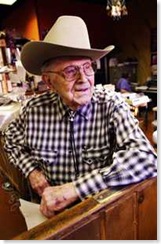The Economist always comes through with something of interest, and last week it was an obituary for Jack Weil, founder of Rockmount westernwear, who was pretty much the creator of the cowboy shirt as we know it: the ones with the snap fasteners instead of buttons, the trim fit, and the yokes.
I was not aware until I read the obit that, prior to 1946, cowboy shirts like this didn't exist.
Which, I suppose, shouldn't have surprised me. The Cartwrights on Bonanza didn't wear any duded up cowboy shirts. The one shirt each they did have, which seemed to last them the entire run of the series, were like any old LL Bean or Cabela's shirt - only with even more staying power.
And I just googled Tom Mix and William S. Hart, those old time, silent movie cowboys, and neither of them had on a classic cowboy shirt in their wikipedia pictures.
No, Jack Weil came up with those touches that have become synonymous with the cowboy shirt - some practical (those snap buttons left no button holes to get caught on a steer horn), and some decorative (embroidered designs).
And Jack Weil - what a buckaroo - died at the age of 107 pretty much with his boots on: he worked at his store up until the end.
There's a lot to admire about Jack and his Rockmount business.
It's in downtown Denver, where it's always been and where it's always gonna be. (No suburban strip mall - just a cool old 1908 building.)
Three generations of Weils have been involved in the business.
And their shirts are made in the good old USA.
ROCKMOUNT is one of the last predominantly US made brands. The company feels that its look is American and so should be its product. Being domestic gives it an advantage over the others because fashion moves fast. Now with the internet, fashion moves at the speed of thought. While other brands take months to get to market, ROCKMOUNT can develop new designs in a week, be in the stores in 6 weeks.
The shirts, while not cheap, don't cost and arm and a leg, either. (Or maybe the world has gotten so out of control I don't think an $80 cowboy shirt is all that pricey.)
While Rockmount's shirts are worn by a lot of non-cowboys - including many musicians - and while a lot of them are gussied up, they were designed to be both fashionable and practical.
Jack A. was motivated to develop a distinctive look for cowboys, ranchers and farmers living in the American West. They had special boots and hats but wore ordinary work shirts. Jack A's special shirt styles have many features different from conventional shirts. His ROCKMOUNT shirts are slim fitting to accentuate the body, whereas conventional shirts were boxy. A better fitting shirt is less likely to get caught or snagged while riding the range. The shirt yokes broaden a man's shoulders. The flap pockets fasten to better hold their contents. The snap fasteners have a break away function to let loose if the shirt got caught, and hold more permanently than buttons. Can you imagine a cowboy who likes to sew? [Note: Jack A is the elder. His son, who also seems to have died this year, was Jack B.]
Lots of famous people have worn Rockmount shirts - movie stars, rockers, and at least one president (Ronald Reagan: say what you will about the Gipper, he looked pretty fine in his cowboy shirt). There are lots of celebrity shots on the Rockmount si te. Alas, the one of Henry Kissinger shows him at the Rockmount facility - but not wearing a Rockmount shirt.
te. Alas, the one of Henry Kissinger shows him at the Rockmount facility - but not wearing a Rockmount shirt.
Given that Dr. K wasn't wearing, here's a picture of a Rockmount shirt, as worn by the late Jack Weil (who, like President Reagan, looked pretty spiffy in his cowboy shirt. And note the bolo tie. While we can praise Jack for the popularization (and urbanization) of the cowboy shirt, he's the one to blame for the creation of the first commercially available bolo tie.
Of course, Rockmount shirts weren't always made for ridin' and ropin' or moseyin' or cowpokin' around.
ROCKMOUNT's magic in popularizing western wear was an appeal to vanity. Cowboys have a strong independent identity and want to be different. Jack A. offered them a special fashion statement. Not so much to be worn while they worked the ranch but to make them stand apart from city slickers when they come to town. These western shirts are dress-up finery, to be worn on Saturday night in town or at the rodeo.
But if you want to see what a real cowboy shirt (not to mention a real cowboy) actually looked like, check out this from Doug and Marna Jean Davis' Shooting Star Enterprise.
So much for the romance of the range - just a toothless, unshaven, no doubt odiferous old coot in a crummy looking (probably none too clean) shirt.
Yippee-kay-ay-o!
2 comments:
Loved this! You did excellent research and brought Jack Weil and his contribution--the iconic western shirt--to life.
Post a Comment